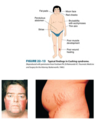7.16 Adrenal Gland Function and Dysfunction Flashcards
Where are the adrenal glands located?
They are pyramidal shaped glands that sit ontop of the kidneys.
The left is shaped like a semicircle while the right is shaped like a party hat

Describe the structureof the adrenal gland
Like the pituitary, the adrenal gland can be thought of as two embryologically and functionally distinct glands that fused during development
There is an adrenal medulla (outer) and an adrenal cortex (inner)

Compare the adrenal medulla to the adrenal cortex in terms of major functions
Adrenal medulla:
- A modified sympathetic ganglion
- Neurohormones
- Secretes catacholamines
Adrenal cortex:
- True endocrine gland
- Classical hormones
- Secretes steroid hormones

Describe the major histological parts of the adrenal cortex and what each part is responsible for
“G.F.R”
Zona glomerulosa –> Aldosterone secretion
Zona fasciulata –> Glucocorticoids
Zone reticularis –> Sex hormones
(note there is some overlap between the zona glomeruosa and the zona fasciulata)

Describe the Hypothalamic-Pituitary-Adrenal Axis and the main outputs from each component
- The hypothalamus secretes corticotrophin releasing hormone CRH which travels through the hypothalamic hypophyseal portal to the anterior pituitary
- The anterior pituitary gland (corticotroph cells) secrete adrenocortitotrophic hormone (ACTH) which travels through the blood to the adrenal glands
- The adrenal cortex cells respond by secreting cortisol
- Cortisol acts via a long negative feedback loop to the hypothalamus and the pituitary

What are the main sex hormones from the adrenal cortex?
- What layers produce them?
Androgens, oestrogens, dehydroepiandosterone (DHEA)
They are produced primarily in the zona reticularis (but also in the fasciculata)
What regions of the adrenal cortex produce cortisol?
- What is the trigger for secretion?
The primary zone is the zona fasciculata (but also in the zona reticularis)
- Cortisol production and secretion is trigger by the hypothalamic-pituitary-adrenal axis (HPAA)
Where are the mineralocorticoids produced?
What stimulates it?
Only the zona glomerulosa produces the mineralocoriticoids (aldosterone)
- It is stimulated by the RAAS pathway and increasing levels of plasma K
How is there a difference in what hormone the cells of the adrenal cortex produce?
Different zones of the cortex have slightly different cells as they each possess different enzymes that are able to cause the production of the different hormones
What is the major common backbone for steroid hormone synthesis?
Cholesterol backbone which is converted to pregnenolone
Draw the (simplified) pathway from cholesterol to the three steroid hormones (include enzymes)
- Purple = Classic female sex hormones
- Blue = Classic male sex hormones
- Green = Glucocorticoids
- Pink = Mineralocorticoid
(Note there a more steps/enzymes in between the ones shown)

What is a major consequence of having a shared synthesis pathway?
They are chemically related leading to a possible cross over effect of their actions
Eg. Mineralocorticoid and Glucocorticoid receptor actions (especially if there is an excess amount of one of them)
What are the higher brain centre functions that trigger/impact the tonic release of CRH from the hypothalamus?
- The circadian rhythm
- Stress
What are the major functions of cortisol in the body?
- Immune system suppression
- Stimulates gluconeogenesis in the liver
- Muscle protein catabolism (substrate for gluconeogenesis)
- Enhances lipolysis of adipose tissue (Fatty acids for energy)
- Causes a negative calcium balance (decreases absorption, increases excretion and causes bone breakdown)
- Influences brain function
- Adaptation to stress

CRH and ACTH have other functions on the body. What are these?
They have stress-related functions in the immune system and the nervous system:
- Inflammation and immune responses
- Inhibition of appetite (through urocortion, a brain neuropeptide)
- Signals for the onset of labour
- Mood disorder effects
What is POMC (pro-opiomelanocortin)?
A large protein that exists in the pituitary glands that is the precursor protein to ACTH
Proteolysis yields several bioactive peptides (in addition to ACTH)
What are the main bioactive products coming from the proteolytic cleavage of POMC in the pituitary gland?
POMC is broken down to form ACTH and beta endorphin (an endogenous opiod that blocks pain perception) as well as other fragments

Post-translational processing of POMC outside the pituitary creates more active peptides. What are they?
Outside the pituitary gland, the ACTH produced is further cleaved to create alpha MSH (melanocyte stimulating hormone) which results in a decrease in food intake (appetite) and increase in skin melanin and may also affect mood.









